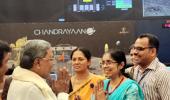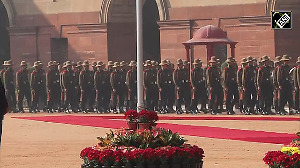'One thing about ISRO is that all the people who work there are passionate about their work.'
'They did not mind spending day and night over there.'
'Even today it is like that.'

With the success of Chandrayaan-3 four Wednesdays ago on August 23, 2023, ISRO has become the flavour of the season.
While applauding the success of those behind the latest success, it is also time to look back at the time when rockets were carried on bicycles.
For those who have come in late, this story is about a scientist who was picked up by Vikram Sarabhai as one of the first engineers at the space centre he was planning in Thiruvananthapuram. That was six decades ago. In 1962.
He was Ramabhadran Aravamudan, popularly known to friends and colleagues as Dan.
Gita, a well-known journalist, married Dan in 1970 and moved to Thiruvananthapuram, thus becoming a part of the ISRO story. They lived there for more than two decades till Dan was appointed director of the ISRO Satellite Centre in Bangalore.
"Dan would have been very, very, proud of Chandrayaan. He would have been absolutely thrilled," Gita Aravamudan tells Rediff.com's Shobha Warrier.
The first of a fascinating two-part interview:
When I spoke to Dan in 2014, he had said that the contrast between the big cities he had lived, and Trivandrum was quite stark. Did you also have cultural shock when you moved to Trivandrum after marrying him?
Yes, it was a cultural shock for me also. Both of us didn't know the language, but he picked up Malayalam very fast.
Then, unlike in Bangalore, I was isolated as a journalist, to begin with. I was the only woman journalist going to places like the Secretariat.
I found this quite difficult in the beginning. But then it was just a question of time.
After a few years, I got used to Trivandrum, and I hated to leave the place when I had to, after 20 years.

Dan had spoken about his early days there, like the bus rides to Thumba, breakfast at the railway canteen, visits to Kovalam beach, etc with his bachelor friends like Abdul Kalam. How do you describe their early ISRO days and friendship?
The friendship was very strong. People like Dan, Kalam and the other pioneers who came at that time, especially the bachelors stayed together at the Indira Bhavan.
The bonds which Dan, Kalam, Eswar Das, Sathya, and the others formed was very strong.
This close group of friends used to eat outside together at the railway canteen as they wanted to eat raw rice and not the boiled rice which most restaurants served.
There were also many others who stayed with them at the lodge. It was like one big family.
Even after they got married, the friendship continued.
But Kalam, Eswar Das and Dan had a special friendship as these three went to ISRO together after they were recruited by Sarabhai.
Eswar Das was already married then.
They came to be known as Trimurthis. Dan was in charge of tracking. Kalam was in charge of launching and Eswar Das was in charge of fabrication.
So, they were together professionally also for a long time.
Only Eswar Das is there now, staying with his son in the USA. Both Dan and Kalam are gone. In fact, most of the pioneers are gone now.
When did you become part of this group?
I got married in 1970. It was Eswar Das and his wife who met us at the station, and they had chosen a house for us to stay.
And Kalam and Sathya took us for dinner at the Mascot hotel which was a big place at that time. For us to have dinner at Mascot hotel was a big thing!
Sathya is the person who you see in the iconic picture of two scientists taking a rocket on a bicycle. He is also no more.

Another iconic picture was Dan in a vest sitting on a floor with Kalam ...
It was taken in 1963, much before I got married. I didn't even know about the picture till it came out in the papers.
Dan has written about this picture in his book. Both were sitting on the floor of the altar trying to fix the payload. While he was working, Kalam was telling him to do it fast.
It was taken by the famous French photographer Henri Cartier-Bresson. At that time, he was touring India and had gone to ISRO to take some pictures as he was Sarabhai's friend.
He would sit in some corner with his camera and take pictures. He would not intrude on anybody.
So, Dan and Kalam also did not notice him taking the picture.
This particular picture became very famous; so also the photo of transporting the rocket on the bicycle. That was also taken by Cartier-Bresson.

Did Dan used to talk to you about what they did at ISRO? As a journalist, you must have been curious...
Dan was one person who was happy to share his office memories. Very early on itself, we had decided that I would not write about ISRO because it was not ethically right.
But I knew what was happening there. Not just Dan, but the others also used to talk to me about ISRO.
When all the wives talk, we used to say that ISRO was the first wife of all those people, and we were only second wives!
They would spend almost all the time in the office as they were all so devoted.
One thing about ISRO is that all the people who work there are passionate about their work. They did not mind spending day and night over there. Even today it is like that.

You said ISRO was their first wife. How do you remember the days when there was a launch or something major happening?
For the pioneers, it was very tough because the number of people was much less.
Dan and his team built the first non-military radar in the country and it was installed in Sriharikota.
I remember very clearly the days he was working on the radar. I never knew when he would come home, when he would go back, how tense he was..
If the launch was in Sriharikota, he would be sitting there day and night because you cannot predict what can go wrong.
If you look at the inside of a rocket or a satellite, there are so many small equipments and each one of them created by different teams.
So, building a rocket or a satellite is a joint enterprise.
One of the things Sarabhai said in the beginning itself which is very relevant even today is, 'Apart from the technology which will take us forward, the very act of joining together, putting the complex technology together and solving the problems as a united group is a very important for a growing country because it teaches us how to work on many things unitedly.'
At ISRO, this message is followed meticulously even today.
You must have noticed that those who join ISRO never leave; they continue to stay at ISRO.

Did he have to travel a lot?
ISRO had collaborations with various countries as we didn't have our own technologies then. So, they had to go and learn from other people.
Because Sarabhai wanted to make him knowledgeable about all the places, he had sanctioned tours for him saying, 'You go to whichever places you can learn something from.'
Dan and three other people travelled all over the world where there were space stations, starting from the US to Japan to Australia to Europe...
He went to Australia once when they were dismantling some space stations. Sarabhai sent him there authorising him to buy anything that would be useful to ISRO.

You must have met Dr Sarabhai. How do you describe him?
He was very charismatic, very charming.
Once when Sarabhai had come to Trivandrum, Dan wanted me to meet him. Dan was very proud that he married a journalist. So, he took me to a dinner party hosted for Sarabhai and some other guests.
Dan introduced me to Sarabhai, and he was very good to me showing a lot of interest in what I was writing.
One of his questions to me was, 'Have you collected all your writings?' I hadn't even thought about it then.
He said, 'You should have a scrap book and next time when I come, you should show it to me'.
He also told me, 'We can accommodate you at ISRO so that you can write pamphlets, press releases, etc for us'.
I was over the sky with happiness after the meeting. Unfortunately, he passed away soon after that.
The greatest thing about Sarabhai was he could make each person feel he was very special to Sarabhai. He was not just a good listener, but would be fully focused on what every person says.
These days, people say ISRO scientists are not fashionable, and they wear only ordinary clothes.
In fact, this fashion statement was set by Sarabhai. He would come to work in slippers, wearing a loose kurta and pyjama. So, the others felt they should dress like him.
Wearing slippers to office became the symbol of ISRO. Nobody wore shoes there. Even those who came back from the United States wore only slippers to work.
- PART 2: 'The Magic Continues At ISRO'
Feature Presentation: Ashish Narsale/Rediff.com









